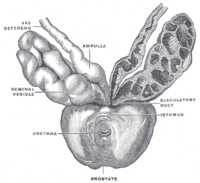Seminal vesicle
The seminal vesicles are a pair of tube-like glands. They are found behind the bladder of males. They make about 70% of the content of semen (also called seminal fluid).

Anatomy
changeBoth vesicles are about 5 cm in length, but they are curled up. Each gland makes a ball shape on the wall of each vas deferens. There is a tube linking the seminal glands which opens into the vas deferens and prostate gland.
From inside to out, the layers making the vesicles are:
- Mucosa - folded to increase surface area
- Muscle
- Connective tissue
Use
changeThe seminal vesicles make most of semen, but during ejaculation, most of the ejaculate has sperm rather than semen in it. The use of seminal fluid is not known, since sperm do not move or survive well in semen. Some think that it acts as a fluid to stop sperm from another male impregnating the female so that the children of only one male can survive.
Seminal fluid has proteins, enzymes, fructose, mucus, vitamin C and flavins. The fructose gives sperm energy and 'food'.
Gallery
change-
Male reproductive system
-
Male organs seen from right side
-
Bladder with the seminal vesicles
-
Vertical section of bladder, penis, and urethra
Other websites
change- SUNY Labs 44:04-0202 - "The Male Pelvis: The Urinary Bladder"
- SUNY Labs 44:08-0103 - "The Male Pelvis: Structures Located Posterior to the Urinary Bladder"